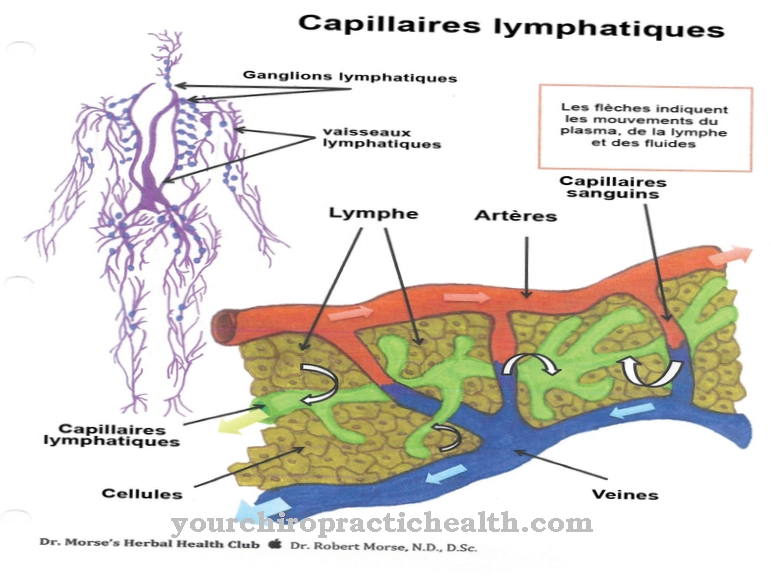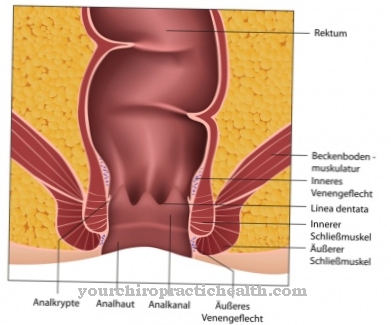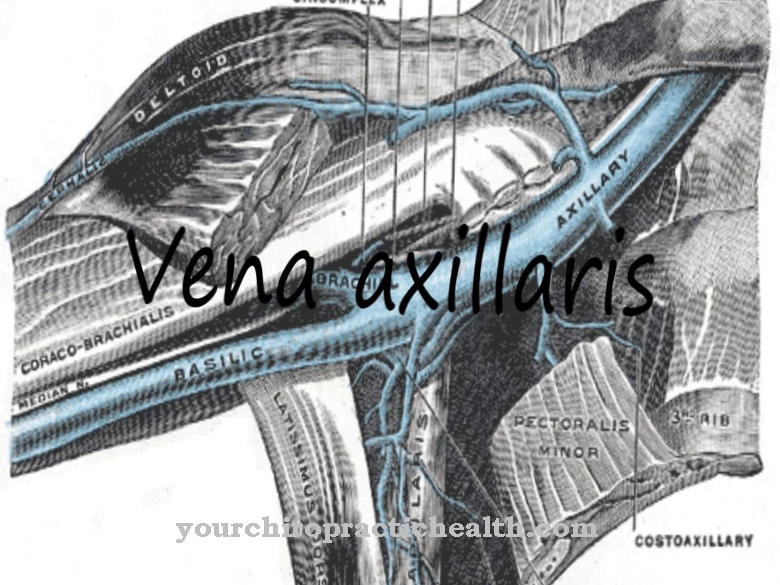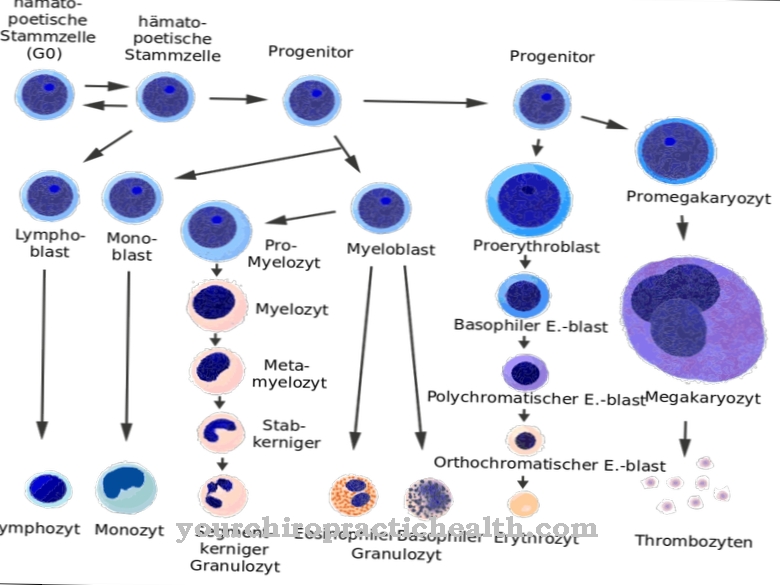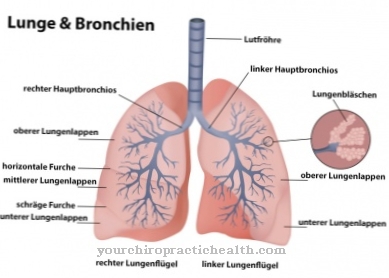Of the Sympathetic refers to a part of the vegetative, involuntary nervous system. It influences and innervates a number of organ and body functions. The ergotropic effects emanate from it, which means that it increases the body's willingness to perform and act according to the primeval pattern of “fight or flee”.
What is the sympathetic system?

The vegetative nervous system, i.e. the nervous system that cannot be arbitrarily influenced, consists of the sympathetic, parasympathetic and intestinal nervous system (enteric nervous system). Vital functions such as breathing, metabolism and digestion, but also blood pressure and salivation and much more. are subject to the autonomic nervous system.
It is subject to the central control of the brain and the hormonal system and not only ensures that organ functions are optimally adapted to living conditions, but also that the stress and rest tone function properly. The sympathetic and parasympathetic nervous systems affect almost all organs, as antagonists or opponents. This antagonistic effect enables a wide variety of body functions that automatically adapt to changing requirements and cannot and must not be influenced and controlled willingly.
In this antagonistic interplay, the sympathetic nervous system behaves ergotropically, that is, it is the source of the impulses that make the body more willing to perform and also cause the reduction of energy reserves. Both the sympathetic and the parasympathetic nerve pathways lead from the brain and spinal cord, i.e. the central nervous system, to the individual organs. For example, they end up in the muscle cells of the heart, the intestinal wall, the pupillary muscles or the sweat glands.
The autonomic nervous system, especially the sympathetic nervous system, immediately increases blood pressure when you get up in the morning to prevent dizziness and to prepare the body for alertness and performance. In extreme heat, for example, it activates the sweat glands. This means that the flow of information is also reversed, namely nerve impulses are transmitted from the organs (e.g. from the heart, the intestine or the bladder) to the brain.
Anatomy & structure
The sympathetic nervous system comprises a widely branched, complex network of nerves that is controlled centrally by the hypothalamus, the brain stem and the reticular formation, a network of neurons in the brain. These send impulses to the sympathetic root cells that are located in the spinal cord. This is where the core areas of the peripheral sympathetic nerve - the so-called first neurons or sympathetic root cells - lie in the area of the breast and lumbar cord, i.e. in the thoraco-lumbar system.
These root cells, located in the lateral horn of the spinal cord, form the so-called nucleus intermediolateralis and the nucleus intermediomedialis. From there, fiber systems go into the paravertebral ganglia, the accumulations of nerve cells next to the spine. These interconnected nerve cords are called the sympathetic trunk, or the sympathetic trunk. This also extends into the cervical spine area and the sacrum area. The three cervical ganglia are found in the neck area. The lowest ganglion can already be connected to the first thoracic or thoracic ganglion (the so-called ganglion stellatum).
In this area there are twelve thoracic ganglia on both sides of the spine in the aforementioned borderline. Four ganglia run in the lumbar area and in the sacral medulla there is still a single, "unpaired" ganglion (the so-called ganglion impar) after the last fibers have joined. In the first step, the neurotransmitters (carriers of the nerve impulse) are acetylcholine. After the first switchover, the second, the so-called postganglionic neuron, transmits the impulse to the respective target organ using noradrenaline.
The sweat glands and the adrenal medulla are an exception here, to which the impulses are also transmitted by acetylcholine. However, there are also axons (nerve nuclei) that leave the sympathetic trunk without switching and lead directly to the target organ (the intramural ganglia). The three sympathetic nerve fibers emerging from the trunk in the chest area are also special.
They pass through the diaphragm and then in turn form three nerve plexuses (nerve plexuses), which then pull to the plexus of the internal organs. The nerve fibers that tone the cerebral blood vessels, migrate to the epiphysis or innervate the eyes, have their origin in the sympathetic trunk of the breast marrow.
Function & tasks
The sympathetic nervous system controls - together with its opponent, the parasympathetic nervous system - largely without conscious perception and willful influencing of vital processes. The target tissues of the sympathetic nerve tracts are especially smooth muscles, e.g. the blood vessels or bronchi, as well as the glands.
While the parasympathetic nervous system ensures general regeneration, the body's own reserve build-up as well as regular body functions at rest, the task of the sympathetic nervous system is to prepare the organism for increased physical performance. In evolutionary terms, it makes the body ready to fight or to flee. The sympathetic nervous system causes the heartbeat to increase in frequency and contraction, and the bronchi to expand for increased lung function and thus better oxygen supply.
Blood pressure rises, as does blood flow and the muscle tone of the heart and skeletal muscles. Glycolysis, i.e. the energy consumption or energy production in the body increases and ensures an increasing, i.e. performance-enhancing supply of cells. This is also accompanied by a general increase in metabolism. In short, it puts the body in an increased willingness to perform, which varies depending on the intensity of the stress reaction.
In addition to the increased willingness to perform, also known as ergotropy, the sympathetic system also ensures a reduction in processes that are not absolutely necessary in combat and on the run, i.e. in stress. This includes intestinal activity (reduced peristalsis and glandular secretion), but also blood flow to the skin (consequences: cold skin and hands, etc.) and mucous membranes, the intestines and kidneys, and even the brain, where the sympathetic nervous system causes blood vessels to constrict.
But it also has an influence on the bladder function (thus enables continence), the genital organs (for orgasm and ejaculation) and glandular secretion (increase in sweat gland secretion, adrenaline secretion from the adrenal gland and reduction in salivary and pancreatic secretion) and on the internal eye muscles (in the form a dilated pupil).
Illnesses & ailments
A disruption in this finely tuned interplay of the sympathetic and parasympathetic nervous systems can, due to its far-reaching influence, have correspondingly complex consequences. When the balance in the autonomic nervous system is generally out of balance, the diagnosis "vegetative dystonia" is often used as an umbrella term for a number of symptoms:
A malfunction of the involuntary nervous system in general and of the sympathetic nervous system in particular can express itself in symptoms such as insomnia, severe weight loss, cramps, nervousness, cardiovascular problems or circulatory disorders. If the neck sympathetic nervous system fails, one speaks of the so-called Horner's syndrome, which causes very specific symptoms: This failure of the sympathetic nervous system causes pupil constriction (so-called miosis due to the failure of the dilatator pupillae muscle) and drooping of the eyelid (ptosis due to the disturbed tarsalis muscle ) and a deeper eyeball (enophthalmos due to the failure of the orbital muscle).
In addition to these clear symptoms in Horner's syndrome, disorders of the sympathetic nervous system can also trigger a variety of vegetative disorders elsewhere. From pathological changes in breathing (shortness of breath or hyperventilation) to changed vascular regulation (the so-called Raynaud's syndrome) to pathological thermoregulation of the body (e.g. excessive sweating or freezing), vegetative dysfunctions or disorders of the sympathetic system can be expressed. A disturbed bladder function in the form of irritable bladder or a pathologically altered gastrointestinal regulation, along with many other metabolic or organ functions, can be indications of a disorder of the sympathetic nervous system.
Hyperhidrosis (excessive sweating) can also indicate a sympathetic disorder. If the suffering is too great for the person concerned and other therapeutic measures do not work, individual ganglia of the sympathetic nervous system are severed or blocked in a sympathectomy in order to remedy the disorder. This endoscopic transthoracic sympathectomy is also used for certain circulatory disorders. In addition, there are generally benign tumor diseases of the sympathetic nervous system, the so-called ganglioneuromas.
In principle, these can develop wherever sympathetic nerve cells (in the peripheral nervous system, i.e. not in the brain) run. They occur mainly in the adrenal medulla, in the sympathetic ganglia next to the spine, but also in the head and neck area, less often in the area of the bladder or the intestinal and abdominal walls. Diseases of the sympathetic nervous system can also lead to a change in the regulation of pain as well as an increased susceptibility to infections and an impaired immune system.

